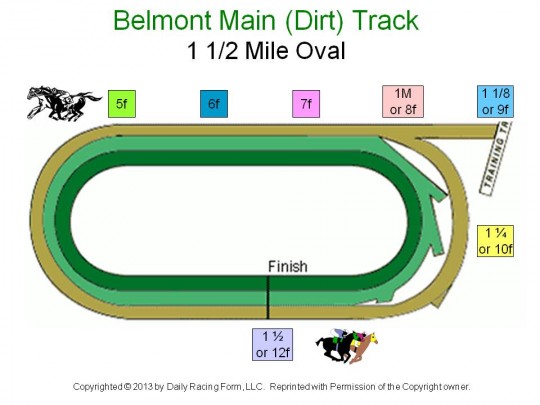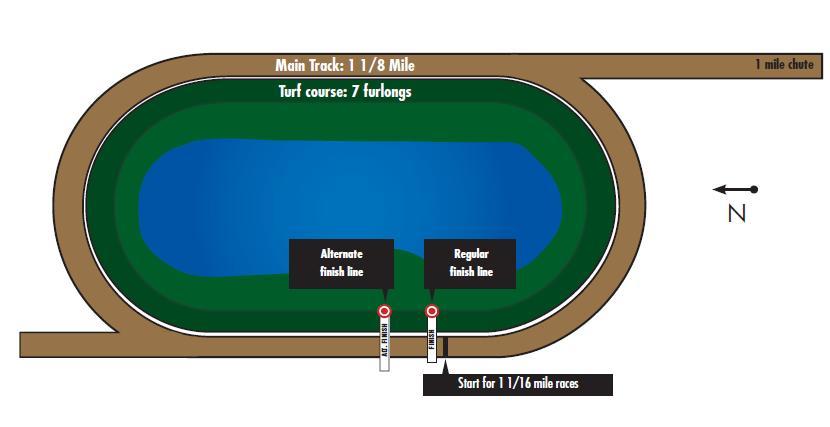Belmont Park – The Green Monster of Racetracks
Belmont Park is The Green Monster of Racetracks, with the largest oval of any thoroughbred racetrack in North America, 11/2 miles in circumference. That’s 12 furlongs, or put in relative terms, 3 furlongs longer than Saratoga and Aqueduct (the other two racetracks on the NYRA circuit). It’s 4 furlongs longer than Santa Anita, Churchill Downs, Monmouth Park, and other 1-mile tracks. Again, in relative terms, that 50% longer than those racetracks. Also, unlike many other racetracks, there are virtually no restrictions on the possible distances of races that can be run at Belmont.
Belmont is a visually stunning racetrack to witness in person. From the stands it seems like the backstretch is miles away. And, due to the structural design, there are no televisions mounted near the grandstand seats. For that reason, binoculars are as essential to the racing patron as a copy of the racing program and a cold draft beer. Fancy hats are optional.
Aside from the sheer grandeur of “beautiful Belmont Park,” as Tom Durkin used to say, there are implications to this behemoth of a racetrack that horseplayers should be aware of when handicapping races here. For example, some starting gate positions at Belmont are not even close to where they are located at other racetracks (for the same distance). Some distances that represent 2-turn races elsewhere, are 1-turn races at Belmont. And, for a race that is identical in distance to that of another racetrack, post positions that are at a disadvantage elsewhere might be advantageous at Belmont … or vice versa.
Below is a diagram of the main dirt track (the outer brown ring) at Belmont Park, with starting gate positions for common distances shown in colored boxes.
Due to the size of the oval, a 9-furlong (11/8 mile) race at Belmont Park is only a 1-Turn race. This is significant for multiple reasons. The obvious being less demand on the horses having to corner into only one turn, as opposed to two turns at other racetracks. Also the long straightaway down the backstretch gives horses ample opportunity to get into position without having to worry about hitting the first turn shortly after the start. Let’s look at a video example from the 2014 Peter Pan Stakes. Keep your eye on #4, Tonalist.
See how Tonalist was able to make a decisive move early on, despite not breaking particularly well from the gate. That type of move would be much harder at a track like Gulfstream Park, where the first turn comes up very quickly after the break in a 9-furlong race. To give you an idea just how quick that first turn comes up at Gulfstream, below is a video replay of the 2015 Florida Derby at an equivalent 9-furlong distance.
Also of interest in watching this video, you can see how the two favorites Materiality (#7) and Upstart (#9) had to use some early speed to get into position before the first turn. Fortunately for them the pace was moderate for the first quarter and half mile … and they were apparently superior horses to the rest of the field. Had the circumstances been different; either a quick early pace or a quality closer in the field, they might have been vulnerable late, having run the final furlong in a modest 13.73 seconds.
The bottom line is that horses stuck in outside post positions at Gulfstream Park (in a 9f race) are at a real disadvantage. They are forced to either hustle out of the gate to gain an early position or fall back before hitting the first turn so they don’t get caught wide and lose ground early in the race.
Contrast that to Belmont Park, where races run at precisely the same distance have completely different dynamics. Horses in inside post positions can be at a disadvantage, especially if they lack any early speed. They can find themselves buried on the rail as quicker horses bolt past them, drift over, and squeeze them back. In fact, if you watch the 2014 Peter Pan Stakes again, notice that Matterhorn (#1) lacked the early speed to get into position, fell to the back of the pack, then was forced to go wide into the stretch in an effort to get around the field of horses that left him behind on the backstretch. This is a great example of how an inside post position at 9f (at Belmont) can be problematic for a horse lacking early speed.
The exact same scenario described above also applies to races of 11/16 miles (8.5 furlongs) on the main track at Belmont Park. At least as it relates to the start of the race, proximity to the first turn, and post position when compared to other tracks. In addition to that, the stretch and finish for an 8.5 furlong race at Belmont Park is dramatically different than Gulfstream Park. Let me explain.
Gulfstream Park is a 9-furlong oval. So, in order to have a race at 8.5 furlongs, and not have the horses start in the middle of the 1st turn, the starting gate is positioned just ahead of the regular finish line and the finish line is backed up in order to shorten the race. You can see this on the following diagram of the track, where the “Alternate Finish Line” is shown.
What’s significant about this? Gulfstream Park already has a very short stretch run, only 898 feet from the top of the stretch to the regular finish line. And the alternate finish line is before the regular finish line. That makes for an even shorter stretch run in 8.5 furlong races.
Contrast that to Belmont Park, which has a stretch run of 1,097 feet, and is never shortened by an alternate finish line. You can now see that an 8.5 furlong race run at Belmont Park (1-Turn, full stretch, no disadvantage to outside post positions) is much different than a race of equivalent distance at Gulfstream Park (2-Turns, shortened stretch, outside post positions are disadvantaged). Just an FYI, Keeneland does the same thing as Gulftream Park utilizing an alternate finish line for 8.5 furlong races on the main track. Click here to read a prior article that compares the many variations in stretch runs amongst major racetracks in North America.
Below is the replay of the 2015 Holy Bull Stakes, run at the 8.5f distance. Among the contenders are Upstart and Frosted. When comparing this race to the Florida Derby, the horses ran nearly 6 seconds less in their stretch run due to to the use of the alternate finish line.
There will be many 8.5f and 9f races during the Belmont Park meet. Being aware of the uniqueness of Belmont Park can be helpful when evaluating the importance of current post positions, running styles, etc. Also,when looking at equivalent distances run by a horse at other racetracks – remember, what looks the same on paper could play out much differently in a race run at The Green Monster of Racetracks, where not all distances are created equal.



6 comments on “Belmont Park – The Green Monster of Racetracks”